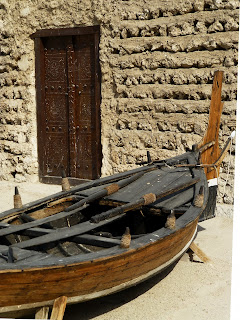 |
| A small water taxi is used to transport pedestrians across Dubai "creek." |
I am combining the two stays, separated by over two weeks, into the same blog. The first two days we did some exploring, a city tour, and got acquainted enough to have an itinerary for the second visit. Neither time did we acclimatize to the weather. We knew it would be hot, and we expected three digit temps. What we did not envision was humidity. My cousin Sharon lived in Tucson for 30 some years and figured she could handle 112-115. Instead, we all felt overcome by the heat. Our eye glasses steamed up so we could not see the moment we left an air conditioned building, and despite drinking copious amounts of water, our journey to the souk left us all flushed, exhausted, and ready for naps in an air conditioned hotel.
So, our main activities were early in the day and in the evenings, or in air conditioned situations. We rode the little water taxis across the "creek" which has good sized cargo boats. We wandered through the souk. We had dinner on a traditional dhow in the evening, we took the elevator 124 floors up in the world's tallest building, we walked through the Plexiglas tunnel in the delightful aquarium, we enjoyed Persian food, and we spent several hours in the huge mall which includes skating rinks, the aquarium, high end stores, lots of restaurants, and an outdoor fountain. The best part was simply sitting and people watching.
 |
| Dubai is a city of old and new, with the new predominating. |
The tradition of hospitality has been relayed to the foreign workers. Taxi cab drivers, store clerks, servers in restaurants, to the general public as we walked about, were unfailingly helpful, courteous, and charming.
.
.
 |
| This is the night view of the city from the observation deck of the Burj Khalifa. The building close to the center is a major high rise although it looks dwarfed from our height. |

This is the model of Burj Khalifa, in the lobby
before entering the fast elevator up.
Dubai's current wealth relates to oil. Within this decade that resource will run out. The current Sheik and his father foresaw this eventuality and began moving Dubai towards a future in tourism, finance and international trade. There is new building going on everywhere and high rises are innovative in their architecture.Amenities for tourists and international business men are everywhere.

 The next set of images are in and from the souk, or traditional market area. The gentleman is measuring saffron for us. The empty Styrofoam cups held a wonderful concoction he shared with us. Arab culture includes the hospitality of sharing beverages such as tea with customers or guests. This drink was a smoothie of avocado, camels milk, sugar and spices. It was delicious and made our purchase all the more memorable.
The next set of images are in and from the souk, or traditional market area. The gentleman is measuring saffron for us. The empty Styrofoam cups held a wonderful concoction he shared with us. Arab culture includes the hospitality of sharing beverages such as tea with customers or guests. This drink was a smoothie of avocado, camels milk, sugar and spices. It was delicious and made our purchase all the more memorable.
I found the souk less traditional than the souks I experienced in Morocco but it was still enjoyable.
 |
| Traditional style dhows take visitors on evening dinner cruises along the "creek." |
 |
| Display in an old fort which holds an excellent small museum. |
The images below are from inside the mall, an ultra-modern establishment that serves as an entertainment center as well as a place for upscale shopping. A large food court and many restaurants, an ice skating rink, and incredible aquarium with a walk through Plexiglas tunnel, an upscale, Arabian Nights themed area and then the modern shopping area are all enclosed. The elevators to the Burj Khalifa are within the mall and directly outside are fountains, set to music, which go off regularly in the evening hours and rival anything Las Vegas offers in the way of orchestrated fountains.



 |
| Within the mall is an area utilizing traditional Arabic architecture. This is not the major shopping area of the mall, but clearly an area for quiet enjoyment and photo opportunities. |






No comments:
Post a Comment